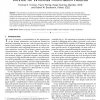Free Online Productivity Tools
i2Speak
i2Symbol
i2OCR
iTex2Img
iWeb2Print
iWeb2Shot
i2Type
iPdf2Split
iPdf2Merge
i2Bopomofo
i2Arabic
i2Style
i2Image
i2PDF
iLatex2Rtf
Sci2ools
TC
1998
1998
The InfoPad Multimedia Terminal: A Portable Device for Wireless Information Access
—The architecture of a device that is optimized for wireless information access and display of multimedia data is substantially different than configurations designed for portable stand-alone operation. The requirements to reduce the weight and energy consumption are the same, but the availability of the wireless link, which is needed for the information access, allows utilization of remote resources. A limiting case is when the only computation that is provided in the portable terminal supports the wireless links or the I/O interfaces, and it is this extreme position that is explored in the InfoPad terminal design. The architecture of the InfoPad terminal, therefore, can be viewed as essentially a switch which connects multimedia data sources in the supporting wired network to appropriate InfoPad output devices (e.g., video display), and connects InfoPad input devices to remote processing (e.g., speech recognizer server) in the backbone network.
| Added | 23 Dec 2010 |
| Updated | 23 Dec 2010 |
| Type | Journal |
| Year | 1998 |
| Where | TC |
| Authors | Thomas E. Truman, Trevor Pering, Roger Doering, Robert W. Brodersen |
Comments (0)

